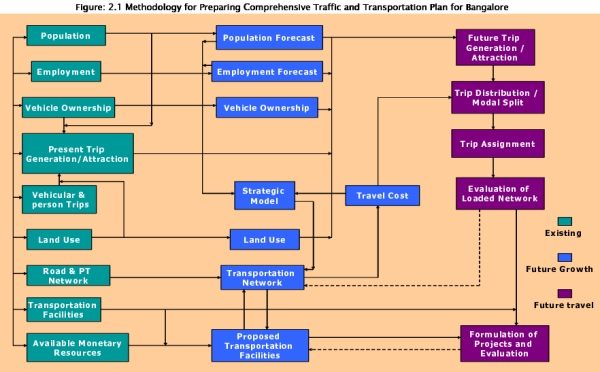Chapter–2 Study Objectives And Methodology
STUDY OBJECTIVES AND METHODOLOGY
2.1 STUDY GOALS
The present study goals include:
i) Development of transportation network to achieve convenient and cost effective accessibility to places of employment and education for the next 20 years;
ii) Optimal utilization of funds and human resources.
2.2 OBJECTIVES OF THE STUDY
i) Identify travel pattern of residents of the local planning area of Bangalore which is co-terminus with the territorial jurisdiction of Bangalore Development Authority (BDA);
ii) Select, develop and operationalise an Urban Transport Planning model using state of the art modeling techniques and software package, appropriate to the conditions and planning needs of the study area;
iii) Assess the relevance of the existing strategy, identify the consequences of pursuing alternative transportation strategies and recommend / update a long – term comprehensive transportation strategy for the study area up to 2025 (2015 and 2025);
iv) Identify for all modes, a phased program of appropriate and affordable investments and policy proposals; and also integration of various modes of mass transits.
v) Help strengthen transport planning skills, and transfer all data, planning model/tools and knowledge obtained through the study to KUIDFC and other agencies such as BDA, BMTC, KSRTC, South Western Railway, BMRTL, Traffic Police, etc.
vi) Strategize transport policy as an integrate part of urban planning
vii) Recommend institutional mechanism for inter agency co-ordination
viii) Assess existing infrastructure and forecast requirement - short term and long term.
2.3 SCOPE OF THE STUDY
In line with the specific objectives of the study described above, the scope of work is divided roughly into the following areas of activities as follows.
i) Collecting household, land use, and travel demand data
ii) Development and operation of an urban transport model
iii) Formulation of transport strategy and institutional mechanism;
iv) Identification of a phased program of transport investments and management proposals; and
v) Training and knowledge transfer to the concerned agencies
2.4. STUDY METHODOLOGY
The adopted study methodology to achieve the set objectives and scope is given in Figure 2.1. The study methodology adopted can be broadly divided in to five stages.

Stage 1:
Finalisation of study methods
-- Secondary data collection and analysis.
-- Finalization of zone plans and hierarchy of zones
-- Detailed sampling basis and questionnaires for Household interviews, Business interviews and Roadside interviews.
-- Base road and public transport network survey.
-- Draw up Proposal for traffic surveys like speed- flow, parking, traffic counts, network inventory, and their analysis.
-- Required computer program suites etc.
Stage 2:
The second stage was the collection of information, and review of existing transport scenario. In order to collect various travel information following surveys were conducted.
-- Household interviews
-- Roadside interview surveys
-- Public transport surveys
-- Traffic surveys
-- Road network inventory
-- Speed and delay studies
The data so collected was analyzed and validated to the existing traffic scenario which forms an input to the transport models.
Stage 3:
Development of detailed operational model forms the fourth stage of the study, this included
-- Development of observed trip matrices
-- Calibrate and validate trip end models
-- Formulation of projects necessary to fulfill the requirement of master plan using forecast models
-- Calibration and validation of trip distribution – modal split model
-- Validation of Assignment models and running them for different schemes/combination of facilities
-- Formulation of management policies
Stage 4:
The fourth stage involved development of Transport Strategy for Bangalore
-- Taking stock of current situation of Bangalore – Urban Transport Policy, Economic growth, current initiative, land use plans both existing and proposed etc.,
-- Analyzing the traffic situation in terms of present situation and constraints and future growth.
-- Proposed land use based on the newly prepared Master Plan.
-- Analyzing the transportation demand vis-à-vis the supply and the constraints.
-- Analyzing the present institutional arrangement and future requirement.
Stage 5:
The fifth and the final stage of CTTS study involve the following:
-- Development of various strategies to address the transport requirements
-- Evaluation of strategies based on selected criteria (mobility, congestion, safety, environmental and economic) and recommendation of suitable strategy
-- Drawing up a Transport Plan for BMA and investment requirements
-- Preparation of investment program for various schemes in operational plan,
-- Carrying out a financial analysis of the proposals identified for Implementation in regard to implementing agencies with funding options
-- Carrying out economic analysis for the recommended strategy to establish viability
-- Recommending Organizational set up and institutional arrangement for implementation of plan.
| Attachment | Size |
|---|---|
| 002_Study Objectives and Methodology oct 07.pdf | 47.88 KB |